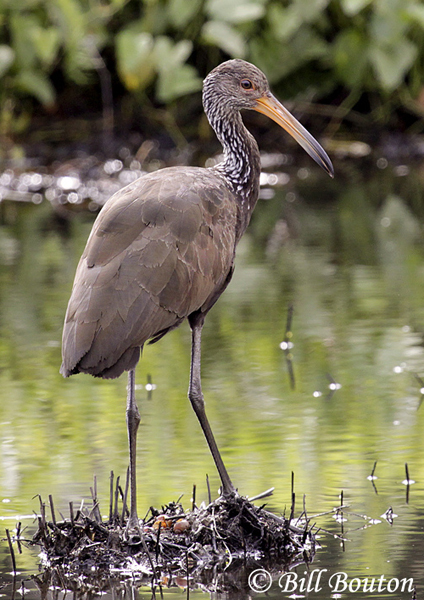| Length: 26 inches | Wingspan: 40 inches | Seasonality: Non-resident in South Dakota |
| ID Keys: Brown overall, white spotting on neck and head, thick long bill | ||
 The
Limpkin is a unique wading bird of the American tropics, with a population
in Florida marking the northernmost extent of the species. Throughout
their range, Limpkins depend heavily on apple snail populations for feeding.
Their bills are specialized for feeding on the snails, with a slight curve
to the right near the tip to aid extracting snails from their shells, and a
gap near the tip that facilitates grasping snail shells. Nicknames for
the Limpkin include "Crying Bird" or "Wailing Bird", as their piercing,
screaming calls are a distinctive sound of Florida swamps, and can often be
heard for long distances.
The
Limpkin is a unique wading bird of the American tropics, with a population
in Florida marking the northernmost extent of the species. Throughout
their range, Limpkins depend heavily on apple snail populations for feeding.
Their bills are specialized for feeding on the snails, with a slight curve
to the right near the tip to aid extracting snails from their shells, and a
gap near the tip that facilitates grasping snail shells. Nicknames for
the Limpkin include "Crying Bird" or "Wailing Bird", as their piercing,
screaming calls are a distinctive sound of Florida swamps, and can often be
heard for long distances.
Habitat: Found in freshwater swamps, typically wooded swamps.
Diet: Feeds heavily on large snails, but also will feed on mussels, large insects and their larvae, frogs, salamanders, lizards, and worms.
Behavior: Foraging is done by walking in shallow water, visually identifying food items as it walks. Limpkins will also prove in mud and below water with their bills. Upon locating a snail, they will typically move to dry land before extracting the snail from its shell.
Nesting: The nest of a Limpkin is a platform built of grasses and wetland vegetation. Placement of the nest varies from on the ground to 20 feet or higher in woody wetland trees. Both parents help to incubate the eggs, and the young are tended by both parents.
Song: The call of a Limpkin is a striking, distinctive screaming sound.
Migration: Considered a permanent resident in the U.S. portion of its range, not likely to stray far from its home range. In the American tropics, populations do make relatively short distance movements in response to local habitat and wetland conditions.
Interactive eBird Map: Click here to access an interactive eBird map of Limpkin sightings
Similar Species: Distinctive if seen well. Perhaps most likely to be confused with the Glossy Ibis or White-faced Ibis.
Conservation Status: In the U.S. portion of their range, Limpkins were nearly extinct by 1920, as hunting decimated populations in Florida. With protection, populations have since recovered somewhat, but are undoubtedly below historical levels, given the initial population losses, and a continuing loss of habitat in Florida. They are a widespread and common species in much of the tropical Americas, and the IUCN lists the Limpkin as a species of "Least Concern".
Further Information: 1) Limpkin - Audubon Guide
2) BirdLife International - Limpkin
3) WhatBird - Limpkin
Photo Information: Photo taken by Bill Bouton - November 2nd, 2009 - Manu Wildlife Center, Peru - Photo licensed under Creative Commons Attribution ShareAlike 2.0 Generic License.
| Click below for a higher-resolution map |
 |
| South Dakota Status: Non-resident in South Dakota |
Additional Limpkin Photos (coming soon!)
